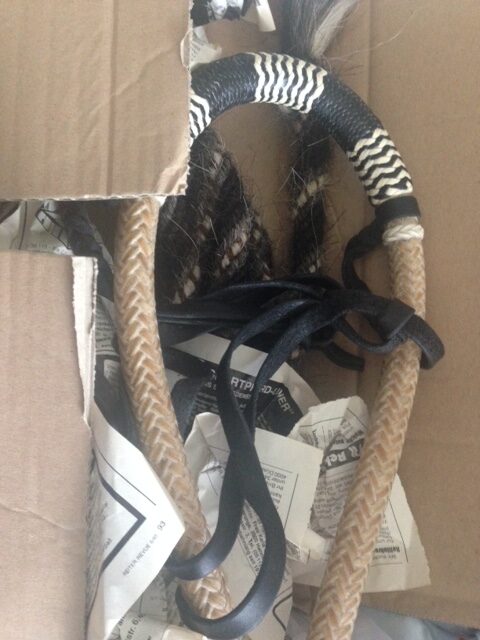Where to find a great rawhide bosal (hackamore)?

I have ridden for many years in a rope halter, but a few years back the time had come for me to transition to riding my horse Ozzie in a bosal & mecate.
The rawhide hackamore (bosal & mecate) is like a more subtle rope halter. You can do tiny rein movements and the horse will still feel them. The more subtle & smaller my aids can be, the better.
It works on pushing the horse, instead of the rope halter which involves a greater pull action. The rider needs to have very good & sensitive hands to use one.
And the signal is more consistent for the horse. A rope halter moves around the horse’s face a lot. But the design of the hackamore allows it to fit snug around the horse’s nose, the same way you would wear a hat on your head.
The bosal is always meant to fit snug (but not tightly) around your horse’s nose.
There is not meant to be any gaps visible between your horse’s nose & the bosal.
As these are quite a sophisticated tool, first I needed to get one made that was of a high quality and fit my horse exactly.

You can get bosals (the rawhide part that goes around the nose of the horse) that are stiff and soft. You do not want one that’s really stiff, it won’t work properly.
When you hold both ends of the hackamore in your hand and squeeze then, you should be able to create a little wave in the hackamore (noseband) part. Too stiff = not good.
And you don’t want one that is very soft or floppy. As it won’t work properly either.
The hanger in the bosal (leather bit that goes around the poll) should be a simple piece, of leather, and not a standard headpiece from a bridle, as that is not how traditional Californian bosal & mecates work
The mecate is the reins. Horsehair mecates are traditional. I use horsehair. While it can be a bit prickly for the first ride or two, I love it now.
Can I get a cheaper, starter hackamore?
Unfortunately the answer is no. There are lots of cheaper ones out there you need to avoid. I’ve even seen very expensive ones at the big horse shows (over €500 euros) that are awful and made with cheap material! But they are not going to work either.
Because they are not made using the correct traditional materials, and so the whole engineering of them is off. The way they are put together is just wrong.
Unfortunately if you buy one of these you’ll end up with a piece of ‘you know what’ that doesn’t work, and no way to sell it on afterwards.
A big reason there are expensive is that they are made by hand (which takes time), with the traditional materials (which are not cheap) using the traditional methods (which takes study & practice to master).
Where should I get a good one?
You shouldn’t buy these in a normal tack shop or at a large horse show – they have to be ideally handmade for your horse, only by a specialist & traditional maker.
There are a LOT of badly made and unusable hackamores on the market. I’m not joking.

Or if you buy from a reputable seller (they are only a few), they will ask you to measure your horses face & they will suggest a size that will suit.
One thing – unless you’ve years of experience with hackamores already – the diameter of hackamore you will buy is 5/8 inches.
Yup, this is regardless of horse breed or size. Large horses right down to riding ponies start with a 5/8 hackamore.
- A larger diameter hackamore can be used to start a horse ONLY if you have a ton of hackamore experience.
- A smaller diameter hackamore can be used for an advance riding horse ONLY if you can ride all lateral movements perfectly, one handed, in all gaits with balance, lightness & lightness.


Grab the free bitless bridle guide.
I’ve put together a bitless bridle & hackamore guide that you can download for free. It goes through all the main halter & bitless bridle & hackamore types, and should help you narrow down which option would work best for you & your horse.
Learn more & grab a copy at www.bitlessbridleguide.com





